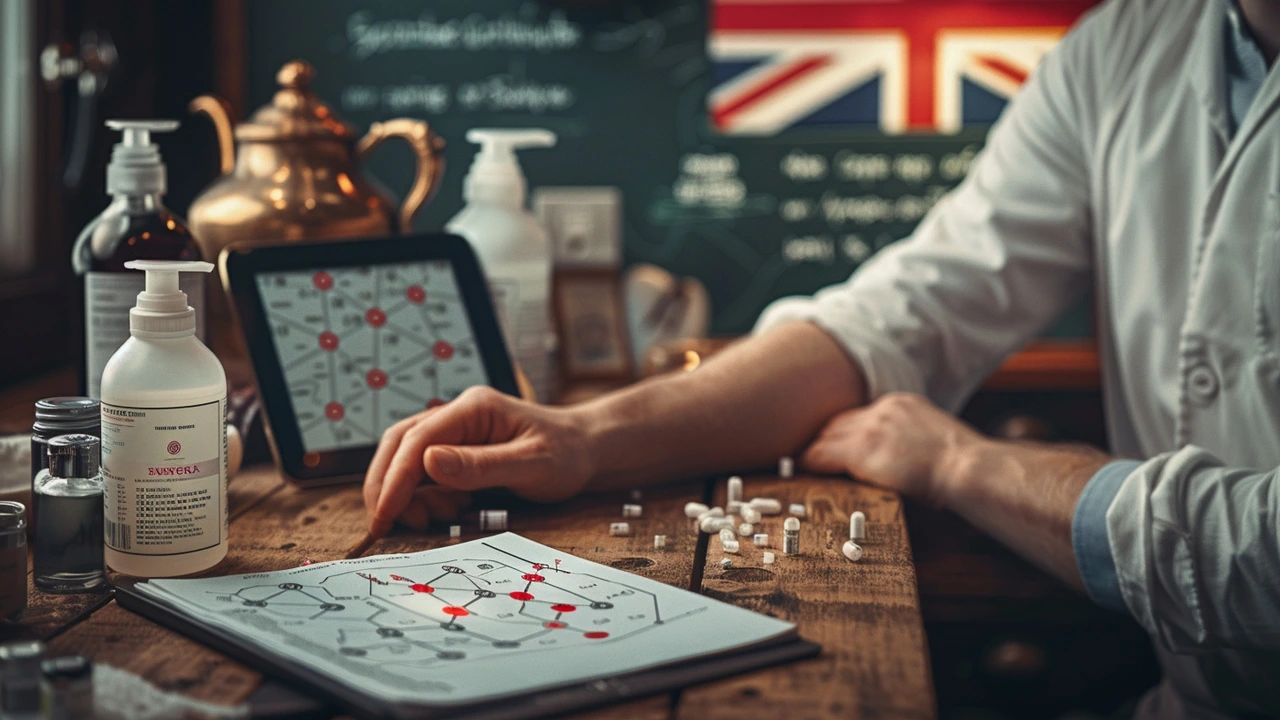Ringworm, despite its name, isn't caused by a worm but by a fungal infection. It creates itchy, circular rashes on the skin. Treating this condition effectively requires the right approach, including the use of ciclopirox, a powerful antifungal medication.
Ciclopirox is an antifungal agent that can stop the growth of the fungi responsible for ringworm. By understanding how to use it correctly and following preventative measures, you can avoid the discomfort and spread of this common skin problem.
This article will take you through the basics of ringworm, explain how ciclopirox works, and provide tips to ensure you’re using the medication correctly. You'll also learn handy prevention techniques to keep ringworm at bay and know when it’s necessary to see a doctor.
- Understanding Ringworm
- How Ciclopirox Works
- Using Ciclopirox: Step-by-Step Guide
- Prevention Tips
- Common Mistakes to Avoid
- When to See a Doctor
Understanding Ringworm
Ringworm, a term that can be quite misleading, is a fungal infection affecting the skin, hair, or nails. Scientifically known as tinea, it derives its name from the characteristic ring-like, red rash it causes. Despite the name, no worms are involved. The infection is caused by dermatophytes, a group of fungi that thrive on keratin, a protein found in the outer layer of the skin, hair, and nails. This pesky fungus can cause discomfort, itching, and visible irritation, making it important to address quickly.
Ringworm can be spread through direct skin-to-skin contact with an infected person or animal, or even indirectly through contact with contaminated objects like towels, clothing, or bedding. It's common in warm, moist environments, which provide the perfect breeding ground for fungi. Sharing personal items or not keeping proper hygiene can increase the risk of contracting ringworm.
Symptoms include a red, scaly patch or bump that can evolve into the classic ring-shaped rash. The center of the patch might be clear or scaly, and the edges can be raised and distinct. This infection can appear on various parts of the body, such as the scalp, feet (athlete's foot), and groin (jock itch). Recognizing these signs early on can help in taking timely action.
Common Types of Ringworm
Different types of ringworm affect different parts of the body. Tinea corporis affects the body’s skin; tinea capitis targets the scalp, often causing hair loss in patches; tinea pedis, widely known as athlete's foot, affects the feet; and tinea cruris, or jock itch, impacts the groin area. Each type can cause unique symptoms, but the red, itchy rash is a common denominator.
Ringworm Transmission and Risk Factors
Anyone can get ringworm, but certain factors can increase your risk. Age plays a role; children are more prone due to their close contact in schools and playgrounds. Participating in sports, particularly those involving close contact, such as wrestling, also heightens risk. Living in a warm, humid environment can facilitate the spread of the fungi, as can having a weakened immune system.
Preventing ringworm involves maintaining good personal hygiene, such as keeping your skin clean and dry, not sharing personal items like clothing or towels, and being mindful of potential sources of infection. Wearing flip-flops in communal showers and drying your feet thoroughly after washing can also go a long way in prevention.
It's worth noting that ringworm is highly treatable. Topical antifungal medications, like ciclopirox, are effective in managing the infection. Applying the medication as prescribed and following through with the treatment duration is essential to completely eradicate the fungus and prevent recurrence.
How Ciclopirox Works
Ciclopirox is a highly effective antifungal agent designed to treat a variety of fungal infections, including ringworm. It works by disrupting the cell membrane of the fungi, which is essential for their survival. This disruption prevents the fungi from growing and multiplying, effectively halting the infection. By doing so, ciclopirox targets the root cause of the infection rather than just alleviating the symptoms.
When applied topically, ciclopirox penetrates the outer layers of the skin. This allows it to reach the infected area directly, ensuring that the medication can work where it’s needed most. This penetration is crucial for breaking down the fungal cells' structure. Specifically, it inhibits the enzymes that are essential for the fungi’s energy production and cell wall building.
One of the interesting aspects of ciclopirox is its broad spectrum of activity. It is effective against a variety of fungi, such as Trichophyton and Epidermophyton, which are commonly responsible for ringworm. By targeting multiple types of fungi, ciclopirox ensures a higher chance of effectively treating the infection.
Another advantage of ciclopirox is its anti-inflammatory properties. It not only tackles the fungal infection but also helps to reduce the inflammation and itching associated with ringworm, providing relief from the discomfort. This dual action makes it a preferred choice for many.
Applying ciclopirox usually involves cleaning and drying the infected area before applying a thin layer of the medication. It’s typically recommended to continue the treatment even after the symptoms have disappeared to ensure that the fungus is completely eradicated. Persistence and proper application are key to preventing a recurrence.
"Ciclopirox has been a game-changer in the treatment of fungal infections," says Dr. Emily Jenkins, a dermatologist at Skin Health Alliance.
In clinical studies, ciclopirox has shown favorable results. A significant percentage of participants experienced marked improvement or complete resolution of their infection after a few weeks of consistent use. These outcomes underscore the effectiveness of ciclopirox when used as directed.
Lastly, ciclopirox is generally well-tolerated, with minimal side effects. Some might experience mild itching or redness at the application site, but these are usually temporary. Its safety profile makes it a go-to solution for many suffering from ringworm and other fungal infections.
Using Ciclopirox: Step-by-Step Guide
When it comes to treating ringworm with ciclopirox, it’s important to follow a clear strategy to ensure effective results. Let’s break it down into manageable steps, from preparation to application.
Step 1: Preparation
First, make sure the affected area is clean and dry. Wash the area gently with soap and water, and then pat it dry with a clean towel. Avoid scrubbing the infected area as it can worsen the condition. Make sure your hands are also clean to prevent any further contamination.
Step 2: Application
Open the ciclopirox tube and squeeze a small amount onto your fingertip. You don’t need a lot—just enough to cover the affected area with a thin layer. Gently apply the medication to the ringworm, taking care to extend a bit beyond the edges of the rash to ensure full coverage. This helps prevent the infection from spreading outward.
Step 3: Frequency
Use ciclopirox exactly as prescribed by your doctor, usually once or twice daily. Consistency is key in antifungal treatment, so stick to a regular schedule, even if the symptoms start to improve. Stopping the treatment early can cause the infection to return.
Step 4: Hygiene
After applying ciclopirox, wash your hands thoroughly unless the treatment site is on your hands. This helps prevent the spread of the fungus to other parts of your body or to other people. Keep the area around the ringworm clean and dry. Moist environments promote fungal growth, so avoid sweating excessively and change any damp clothes immediately.
Step 5: Monitoring Progress
Keep an eye on the infection to monitor its progress. If you see significant improvement within a week or two, that's a good sign that the treatment is working. However, if the condition doesn’t improve or gets worse, it’s important to consult your healthcare provider for further advice.
If you’re using ciclopirox for weeks without any noticeable improvement, contact your doctor. Chronic infections might need a different approach or additional treatments.
Step 6: Additional Care
Avoid covering the treated area with tight clothing or bandages unless directed by a doctor. This can create a moist environment where fungi thrive. Use loose-fitting clothes to allow the area to breathe. As itchy as ringworm can be, resist the urge to scratch, as this can lead to secondary infections and delays the healing process.
“Patience and consistency are key factors in treating ringworm. Skipping doses or improper application can prolong the infection.” - Dr. Elena Martinez, Dermatologist
Final Thoughts
Using ciclopirox as directed can be an effective way to treat ringworm and inhibit the growth of the fungus. Following these steps will help ensure that the treatment is as successful as possible. Always remember, if in doubt, consult your healthcare professional. They can provide guidance tailored to your specific situation.
Prevention Tips
Preventing ringworm involves a combination of good hygiene and cautious habits. Since ringworm is highly contagious and thrives in warm, moist areas, keeping yourself and your surroundings clean is essential. Let's start with personal hygiene.
First, always shower and dry off thoroughly after sweating heavily or swimming. Fungi love moisture, so it's important to keep your skin dry. Using a clean, dry towel for drying off is key. Also, change your clothes every day, particularly underwear and socks. Make sure to wash your clothes regularly in hot water to kill any potential fungal spores.
Next, avoid sharing personal items such as towels, clothing, hairbrushes, or any items that come into direct contact with your skin. This reduces the risk of transferring or picking up fungal spores. If you must share items, ensure they are disinfected and clean. Regarding footwear, opt for open-toed shoes or sandals in communal showers or locker rooms to avoid contact with the floors.
"Ringworm prevention can be as simple as maintaining good hygiene and being cautious about what you share," says Dr. Emily Martin, a leading dermatologist.
It is also wise to keep your living space clean. Regularly vacuum carpets and upholstery and wash bedding frequently. Pets can also carry ringworm, so if you have animals, keep an eye on their skin and fur for any signs of infection. If you suspect your pet has ringworm, take them to the vet early for a quick diagnosis and treatment.
Healthy Lifestyle Habits
Building a strong immune system can help your body fight off potential infections, including ringworm. Keep a balanced diet rich in vitamins and minerals, particularly those with antifungal properties such as garlic and turmeric. Staying hydrated and exercising regularly also bolster your immune system.
Environmental Precautions
Another significant prevention measure is to maintain dry environments. In humid climates, consider using a dehumidifier in your home. Ensure good air circulation to prevent fungal growth in damp areas. If you use public gyms or swimming pools, wipe down equipment before and after use.
Lastly, educating yourself and others is a strong defense against ringworm. Informing family members, particularly children, about the importance of personal hygiene and preventive steps can reduce the spread of ringworm in households and communities.
Common Mistakes to Avoid
When treating ringworm with ciclopirox, avoiding certain mistakes can make the difference between a quick recovery and prolonged discomfort. Many people misuse antifungal creams, leading to less effective treatment. One common error is not applying the medication consistently. To get the best results, you need to use ciclopirox twice daily, or as directed by your doctor, without skipping applications, even if the symptoms seem to have improved.
Another mistake is stopping the treatment too early. Even when the rash looks better, the fungi can still be present and active. It's crucial to continue using ciclopirox for the full duration prescribed—usually two to four weeks—until the infection is completely cleared. Otherwise, the ringworm may return, sometimes even more stubborn than before.
Avoid using the cream only on the visible parts of the rash. You must apply it to the surrounding area as well, as the fungi can extend beyond the visible border of the infection. Proper application ensures that all the fungi are targeted, reducing the likelihood of relapse. Keeping the affected area clean and dry also plays a critical role in effective treatment. Moist environments can promote fungal growth, so dry the area thoroughly after washing.
Overuse of the cream is another issue. Using more medication than prescribed will not speed up recovery and could irritate the skin. Stick to the recommended amount and frequency to avoid unnecessary side effects. Additionally, sharing towels, bed linens, or clothing with others can spread the infection. Keep your personal items separate and wash them regularly in hot water to kill any lingering fungi.
It's also important not to rely solely on ciclopirox for treatment. Maintaining hygiene, keeping the skin dry, and following a healthy diet to boost your immune system are key in conjunction with the medication. These steps can support your body in fighting off the infection more efficiently. Ignoring signs of worsening infection is another pitfall. If the rash does not improve after a couple of weeks, or if it gets worse, consult a healthcare professional. This might indicate a need for a different treatment approach.
Stress and poor diet can weaken your immune system, making it harder to fight off infections. Getting enough rest, eating a balanced diet, and managing stress effectively are additional supportive measures. Remember, patience and consistency are crucial.
According to Dr. John Smith, a renowned dermatologist, "Consistent and correct application of antifungal creams like ciclopirox is essential for treating ringworm effectively. Stopping the treatment early is one of the most common reasons for recurrence."
When to See a Doctor
Using ciclopirox for ringworm can be very effective, but there are times when it’s essential to consult a healthcare professional. One primary reason to see a doctor is if the infection doesn’t improve within a couple of weeks. Persistent symptoms, such as intense itching, redness, or the rash spreading to other parts of your body, indicate that the treatment might not be working, and alternative medications may be necessary.
Another significant reason to seek medical advice is if the rash appears severe or covers a large part of your body. Large or multiple ringworm lesions can require more intensive treatment. Doctors can prescribe oral antifungal medications if topical treatments prove insufficient. In cases where the infection becomes painful or starts to ooze pus, it signifies possible secondary bacterial infection, needing immediate medical intervention.
If you have underlying health conditions like diabetes or a weakened immune system, due to treatments like chemotherapy or conditions like HIV, it’s crucial to see a doctor promptly. These conditions can make skin infections like ringworm more severe and harder to treat. A healthcare provider can tailor your treatment plan to consider these complexities.
Repeated or recurrent ringworm infections also warrant medical attention. If you find yourself battling ringworm frequently, a doctor can help identify any underlying issues that might be making you more susceptible, such as other skin conditions or hygiene practices that need adjustment. In families or communities where ringworm seems to be spreading consistently, a doctor can provide advice on managing and preventing an outbreak.
It's important to watch for signs of a severe allergic reaction to the medication used. Though rare, symptoms such as severe dizziness, trouble breathing, or swelling of the face, tongue, or throat necessitate urgent medical help. If you experience these after applying ciclopirox, discontinue use immediately and contact emergency services.
According to Dr. Heather Kushner, a dermatologist, "Identifying the type of infection and its severity early can significantly influence the course of treatment and recovery."
It’s crucial to understand that each body reacts differently to treatments, and what works for one person might not work for another. Regular check-ups and open communication with your healthcare provider are key. The earlier you address persistent symptoms, the better the outcomes tend to be. If in doubt, always err on the side of caution and schedule a visit with your doctor.
To sum up, while ciclopirox can be an excellent choice for treating ringworm, persistent, severe, or recurrent infections, complicated by other health issues, require professional medical advice. Always monitor your symptoms closely and don’t hesitate to seek help if something doesn’t feel right.







THIS CHANGED MY LIFE 😭 I had ringworm for 3 YEARS and nothing worked until I tried ciclopirox. Now I’m basically a fungal warrior 🦸♀️💥 #NoMoreItch
Ciclopirox? How quaint. In my 2008 dermatology seminar at Johns Hopkins, we used a compounded terbinafine-lavender oil emulsion-far more elegant than this over-the-counter Band-Aid solution.
Honestly, this is such a solid breakdown. I’ve been using ciclopirox for my athlete’s foot and it’s been a game-changer. Just remember: consistency > intensity. Apply it like you’re tucking your skin in for bed-gentle, daily, no exceptions. 🌿
I appreciate how this article doesn’t just shove meds at you. It actually respects that people have lives, pets, and laundry piles. Also, no shaming for using flip-flops in the gym shower. Thank you.
The emphasis on hygiene and persistence is not just medically sound-it’s philosophically profound. We live in a culture of quick fixes, yet healing requires patience, ritual, and attention to detail. Ciclopirox is not merely a cream; it is a commitment to bodily sovereignty.
OMG YES!! I used this for my dog’s ringworm too!! Just dab a lil on the spot and wash hands after!! But like… don’t forget to wash the bed sheets!! I did and then my cat got it 😭😭😭
In Indian households, we used neem paste and turmeric for generations before pills and creams. But I won’t dismiss ciclopirox-it’s science, and science has its place. Still, I wonder: are we replacing wisdom with convenience? The fungus thrives in neglect, not just moisture. Clean hands, clean mind, clean space.
Did anyone else notice the link in the intro goes to a scooter site?
You know, when I first read about ciclopirox, I thought, ‘Another corporate solution to a natural imbalance.’ But then I sat with it. I meditated on the lifecycle of dermatophytes. I asked myself: are we treating the fungus-or are we treating our fear of impermanence? Skin is porous. Life is porous. Ciclopirox is just a bandage on the existential wound of modern hygiene anxiety. 🌌✨